Water-Quality and Ecological Issues
Protection of water quality in rivers and in aquifers in the study area is an important concern. The greatest effects on hydrology, water quality, and aquatic communities occur in areas where the disruption to the natural land cover is substantial.
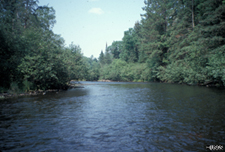
Water quality is affected less in the forested areas of the study unit (Upper Mississippi River and St. Croix River Basins) than in other areas of the Study Unit due to minimal land-cover disturbances. Water quality in
the forested areas may affected by minor applications of herbicides at small farms, tree farms, and in lakes (for weed reduction); discharges of waste-water effluent; leaks from septic systems; local stream-channel disturbances from forestry; and localized draining of wetlands. These activities result in small increases in nutrient, pesticide,
suspended-sediment, and bacteria concentrations relative to natural conditions. In general, there are few physical modifications to stream channels in forested areas with the exception of some areas that are used are used for commercial forestry practices. Aquatic communities are relatively undisturbed in forested areas due to minimal contaminant sources and minimal physical alterations to surrounding land use.
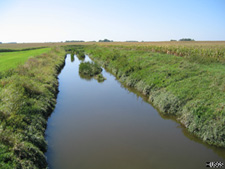
In agricultural areas (most of the Minnesota River Basin and parts of the Mississippi and St. Croix River Basins),water-quality concerns include degradation from point and nonpoint sources of sediment, nutrients, and pesticides, and physical alterations of streams through artificial drainage systems, channel straightening, and removal of riparian vegetation.
Riparian zones are the interface between streams and the surrounding watershed. Wooded riparian vegetation can impede surface runoff and stabilize stream banks thereby reducing the delivery of sediment into
streams.
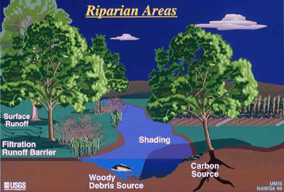 Reduced volumes of sediment delivered to streams may have beneficial effects on aquatic resources by reducing the amount of siltation on fish and invertebrate habitat areas. Reduced sediment in streams increases the visibility for animals that are site predators and increases light penetration that enhances the growth of algae. Reduced volumes of sediment delivered to streams may have beneficial effects on aquatic resources by reducing the amount of siltation on fish and invertebrate habitat areas. Reduced sediment in streams increases the visibility for animals that are site predators and increases light penetration that enhances the growth of algae.
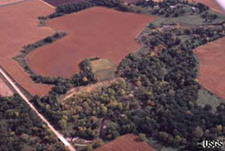 Wooded riparian vegetation absorbs and reflects solar radiation, resulting in greater thermal stability and decreased light availability for primary production. Wooded riparian vegetation increases habitat complexity by supplying woody debris, which contributes to greater variation in channel and provides habitat for invertebrates, especially in low-gradient streams.
Wooded riparian vegetation absorbs and reflects solar radiation, resulting in greater thermal stability and decreased light availability for primary production. Wooded riparian vegetation increases habitat complexity by supplying woody debris, which contributes to greater variation in channel and provides habitat for invertebrates, especially in low-gradient streams.
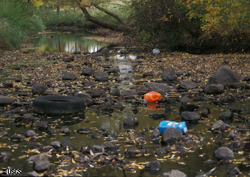
Water-quality issues in the urban areas of the study unit include contamination from point and nonpoint sources and physical alterations.
Point and nonpoint-source contaminants originate from automobiles, road de-icing chemicals, construction, application of pesticides and fertilizers, atmospheric deposition, street debris in urban stream-water runoff, animal and plant refuse, and discharge from industrial and wastewater treatment facilities.
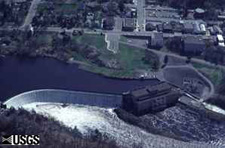
Physical alterations affecting urban streams include impervious surfaces, drainage of wetlands, construction of detention ponds, loss of riparian cover, stream-channel modifications, and the presence of dams.
Impervious surfaces cause greater peak streamflow rates of shorter duration from runoff than would occur naturally, and increase transport of contaminants from streets and parking lots to streams. These factors can increase water temperature and degrade habitat and water quality.
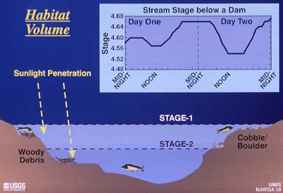
Construction of locks and dams contributes to the loss of floodplain backwater and slough habitats that are important for fish spawning and serve as migration barriers. Hydrologic conditions change due to dam presence and operation.
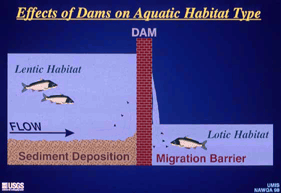 Sediment deposition is greater and stream flow is reduced in areas upstream of dams resulting in more of lentic or lake habitat. Changes in hydrologic conditions may result in shifts in species composition above the dam to those species that prefer lentic habitat rather than stream-like or lotic habitat (greater stream flow). Changes in water levels due to dam operation result in changes in aquatic habitat volume (Mueller, 1993).
Sediment deposition is greater and stream flow is reduced in areas upstream of dams resulting in more of lentic or lake habitat. Changes in hydrologic conditions may result in shifts in species composition above the dam to those species that prefer lentic habitat rather than stream-like or lotic habitat (greater stream flow). Changes in water levels due to dam operation result in changes in aquatic habitat volume (Mueller, 1993).
Mueller, L., 1993, Winged maple leaf mussel and Higginseye pearly mussel - Freshwater mussels threatened with extinction: Minnesota Department of Agriculture, 19 p.
|